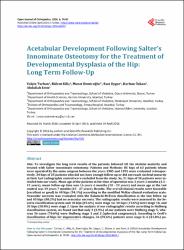| dc.contributor.author | Turhan, Yalçın | |
| dc.contributor.author | Kılıç, Bülent | |
| dc.contributor.author | Demiroğlu, Murat | |
| dc.contributor.author | Uygur, Esat | |
| dc.contributor.author | Özkan, Korhan | |
| dc.contributor.author | Eren, Abdullah | |
| dc.date.accessioned | 2019-01-31T07:59:28Z | |
| dc.date.available | 2019-01-31T07:59:28Z | |
| dc.date.issued | 2016-04 | |
| dc.identifier.issn | 2164-3008 | |
| dc.identifier.issn | 2164-3016 | |
| dc.identifier.uri | http://hdl.handle.net/11363/1068 | |
| dc.description.abstract | Aim: To investigate the long term results of the patients followed till the skeletal maturity and treated with Salter innominate osteotomy. Patients and Methods: 85 hips of 63 patients whom were operated by the same surgeon between the years 1985 and 1991 were evaluated retrospectively. 34 hips of 25 patients who did not have enough follow-up or did not reach skeletal maturity at their last radiographic control were excluded from the study. So, 51 hips of 38 patients were included into our study. Mean age of the patients at the time of operation was 3 years 2 months (1.5 - 11 years), mean follow-up time was 16 years 6 months (10 - 23 years) and mean age at the last control was 19 years 7 months (15 - 27 years). Results: The overall clinical results were favorable (excellent or good) in 48 hips (94.1%) according to the modified McKay clinical evaluation scale. Avascular necrosis was evaluated with the Kalamchi-McEven classification at the last follow up and 45 hips (88.2%) had no avascular necrosis. The radiographic results were assessed by the Severin classification system and 10 hips (19.6%) were stage 1a; 10 hips (19.6%) were stage 1b; and 30 hips (58.8%) were stage 2. Upon the analysis of our radiographic results according to Stulberg classification system, we found out that only 2 (3.9%) of our patients were Stulberg stage 5, whereas 36 cases (70.6%) were Stulberg stage 1 and 2 (spherical congruency). According to Croft’s classification of hips for degenerative changes, 36 (70.6%) patients were stage 0; 6 (11.8%) patients were stage 1; 5 (9.8%) patients were stage 2 and 4 patients (8.7%) were stage 3. Conclusion: When appropriate soft tissue balance is provided, the complications of Salter Innominate Osteotomy are decreased and thus, it provides an excellent functional and radiological result. | en_US |
| dc.language.iso | eng | en_US |
| dc.publisher | Scientific Research Publishing | en_US |
| dc.relation.isversionof | http://dx.doi.org/10.4236/ojo.2016.64012 | en_US |
| dc.rights | info:eu-repo/semantics/openAccess | en_US |
| dc.rights | Attribution-NonCommercial-NoDerivs 3.0 United States | * |
| dc.rights.uri | http://creativecommons.org/licenses/by-nc-nd/3.0/us/ | * |
| dc.subject | Research Subject Categories::MEDICINE | en_US |
| dc.title | Acetabular Development Following Salter’s Innominate Osteotomy for the Treatment of Developmental Dysplasia of the Hip: Long Term Follow-Up | en_US |
| dc.type | article | en_US |
| dc.relation.ispartof | Open Journal of Orthopedics | en_US |
| dc.department | İstanbul Gelişim Üniversitesi | en_US |
| dc.identifier.volume | 6 | en_US |
| dc.identifier.issue | 4 | en_US |
| dc.identifier.startpage | 78 | en_US |
| dc.identifier.endpage | 85 | en_US |
| dc.relation.publicationcategory | Makale - Ulusal Hakemli Dergi - Kurum Öğretim Elemanı | en_US |



















